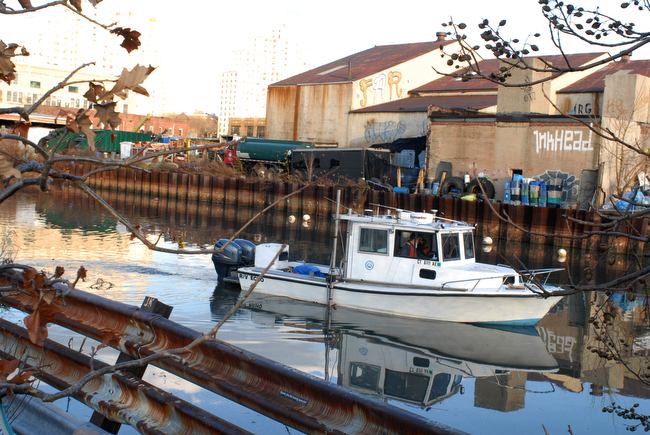
Photo by Joshua Kristal
Following months of tests in the Gowanus Canal, on Wednesday the U.S. Environmental Protection Agency released a report detailing the heavy contamination and pollution in the 1.8-mile waterway. The report warns people against touching in any way the water or the mud in the canal, as it is laden with toxic chemicals and cancer-causing agents. It further warns against eating fish caught in the canal (Apparently, people catch fish and crabs in the canal and eat them, according to the report).
The good news is that the EPA says that, based on extensive tests, it is safe to live and breath around the canal, and to walk over and near it, as long as you do not touch the water.
“Any exposure to the sediment poses a risk. People should avoid it. Boating is OK, but we wouldn’t recommend any diving. No prolonged exposure to the water,†said Mary Mears, spokeswoman for the EPA’s Region Two, based in Manhattan.
The air around the canal is fine, she said, and city drinking water comes from upstate, so is not affected.
“Our tests and studies have shown that basically, the pollution is seeping into the canal, more than seeping out,†said Mears.

Child posing near the somehow romantic canal
The “Remedial Investigation and Risk Assessment†report is the first step since the EPA in March designated the canal a federal Superfund Site, against the protest of Mayor Michael Bloomberg and developers who wanted to build condos along the canal. The federal cleanup is expected to begin in 2013 and take 10 years, at a cost of $300 to $500 million.
According to Wednesday’s report, the canal is “contaminated with a variety of pollutants, including polycyclic aromatic hydrocarbons (PAHs), volatile organic contaminants (VOCs), polychlorinated biphenyls (PCBs), pesticides, and metals. PAH concentrations were found to be as high as 45,000 milligrams per kilogram (4.5%) and the contamination was found to traverse the entire length of the canal. Many of the detected contaminants are known carcinogens.â€
The pollution has been occurring for more than 100 years, and is attributed to many, many sources, Mears said. Companies that can be directly linked to the pollution will help pay for the cleanup, and the agency is “actively identifying potentially responsible polluters who will be brought in,†she said.
The canal was once an oyster bed before it was developed for industrial uses in 1860, and at one point was the busiest industrial waterway in the United States. Now, there are more residents around the canal than industry, but industrial pollution continues to seep in.
“Now we have to figure out how to clean it up,†Mears said.
Over the course of this year, the EPA will hold meetings and study clean-up options and costs.
“We will hold many meetings and involve the public a lot,†Mears said.
The city, state and National Grid are each on the hook for parts of the cleanup, and the EPA is playing the roll of “traffic cop,†Mears said.
The city is working on a $140 million improvement to the sewer system (the construction you see on Degraw Street between Court and Clinton), so that sewage does not overflow into the canal whenever there is a heavy rain. A video showing this overflow after the tornado of 2010 went viral (warning—it’s gross).
But the city will have to do more to fix the problem of the sewer overflow and sewer flooding, Mears said.
“We haven’t evaluated what needs to be done about the combined sewage overflow. We fully support [the city’s] plans, it’s an excellent start, but I believe they’ll have to do more.â€
Ludger Balan, who sits on the EPA’s community board for the Gowanus, founded the Urban Divers Estuary Conservancy in 1998 to bring attention to the pollution in the canal, and to bring attention to the diverse wildlife somehow surviving there, including many types of fish.
He said the report doesn’t surprise him.
“We’ve been screaming about the unknowns for years,†Ludger said. “This is not an open sewage line. It’s a habitat, and we should take care of it. “
Balan lives near the canal.
“We pay these high mortgages, high rents, and we are given this sh*& to live with,†Balan said.
Mears encouraged residents to turn out to a meeting at PS 32, on Hoyt between Union and President, on Feb. 23, at 6:30, to hear more about the canal Superfund cleanup.
“It’s been a great community to work with. That’s not always the case. We’re dealing with a diverse and wonderful community, very engaged, and we want to keep that the case,†Mears said.
